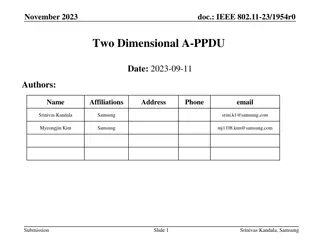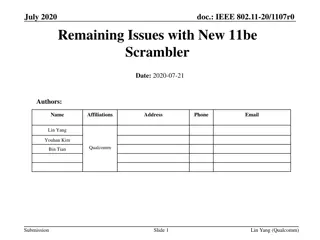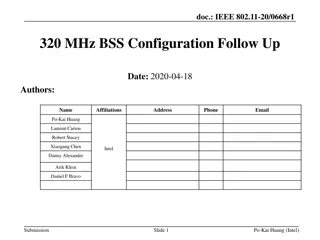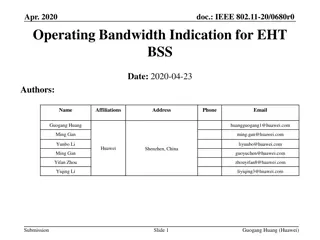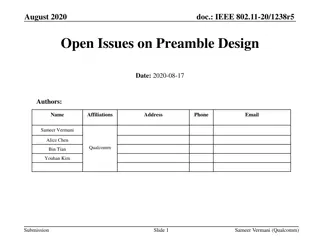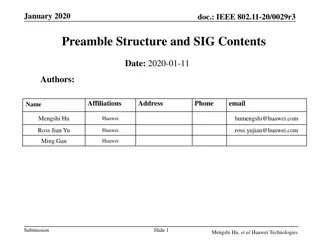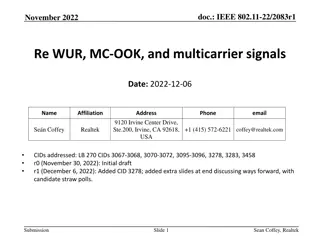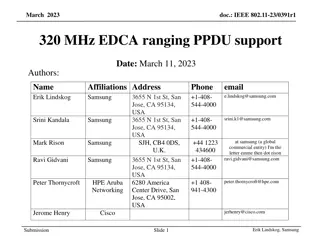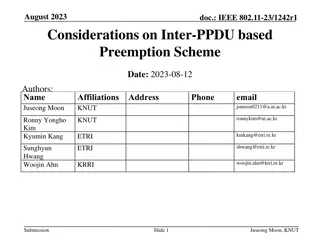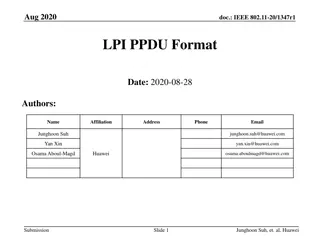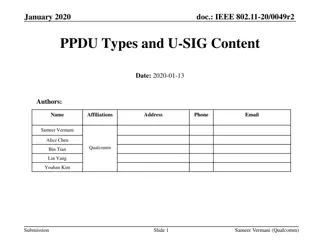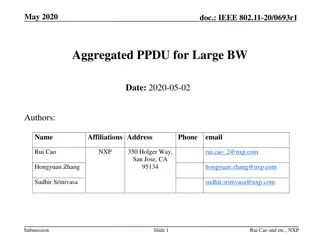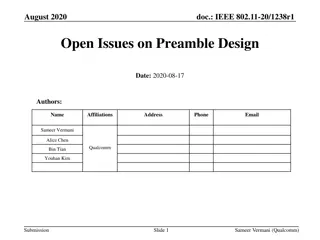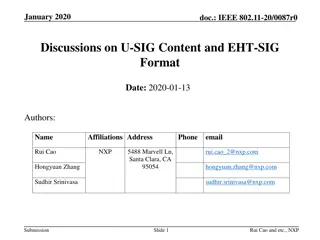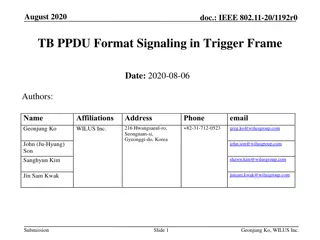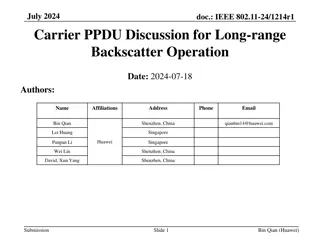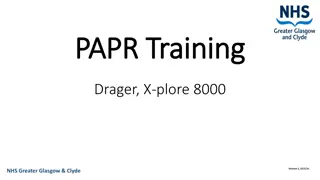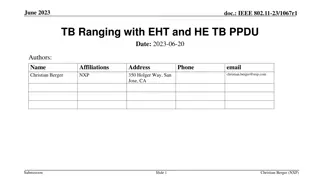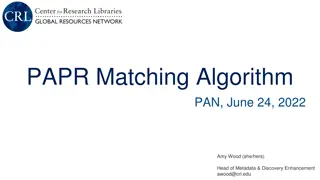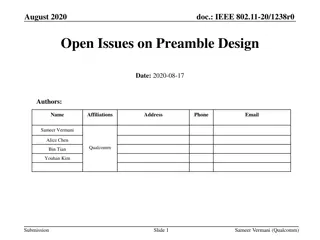PAPR Issues in EHT-ER-SU PPDU for 6GHz Wi-Fi Systems
Introduction of a new PPDU type (EHT-ER-SU) for extending transmission range in 6GHz Wi-Fi systems has led to PAPR issues due to frequency-duplicated data, impacting indoor and outdoor usage. Proposed methods aim to reduce PAPR, addressing concerns for indoor STAs and outdoor support in high-power scenarios.
Download Presentation

Please find below an Image/Link to download the presentation.
The content on the website is provided AS IS for your information and personal use only. It may not be sold, licensed, or shared on other websites without obtaining consent from the author.If you encounter any issues during the download, it is possible that the publisher has removed the file from their server.
You are allowed to download the files provided on this website for personal or commercial use, subject to the condition that they are used lawfully. All files are the property of their respective owners.
The content on the website is provided AS IS for your information and personal use only. It may not be sold, licensed, or shared on other websites without obtaining consent from the author.
E N D
Presentation Transcript
July 2020 doc.: IEEE 802.11-20/1135r1 PAPR issues for EHT ER SU PPDU Date: 2020-07-27 Authors: Name Affiliation Address Phone Email Eunsung Park esung.park@lge.com Dongguk Lim dongguk.lim@lge.com 19, Yangjae-daero 11gil, Seocho-gu, Seoul 137- 130, Korea LG Electronics Jinyoung Chun jiny.chun@lge.com Jinsoo Choi js.choi@lge.com Submission Slide 1 Eunsung Park, LG Electronics
July 2020 doc.: IEEE 802.11-20/1135r1 Introduction To extend the transmission range of the low power indoor Wi-Fi system in 6GHz, a new type of PPDU (EHT ER SU PPDU) was introduced in [1][2] Data part is duplicated in the frequency domain for the non-punctured 80/160/320MHz SU transmission Only BPSK with DCM is used This frequency-duplicated data part leads to an increase in PAPR It may be a harmful issue when EHT ER SU PPDU is used for the outdoor support It may also cause a problem for STAs which only support indoor usage cases in 6GHz In this contribution, we propose a simple method to reduce the PAPR of the data part in EHT ER SU PPDU Submission Slide 2 Eunsung Park, LG Electronics
July 2020 doc.: IEEE 802.11-20/1135r1 PAPR Issue (1/2) For STAs which support both indoor and outdoor environments in 6GHz, a PAPR increase due to the frequency-duplicated data part may cause a problem if this PPDU is used for outdoor cases For the low power indoor transmission, it is highly probable that PA operates within a linear range that means a little increase in PAPR for this low power mode may not cause a critical problem However, for the outdoor support where high power is used for the transmission, this increased PAPR can cause severe signal distortion, and thus, we need a decent method to reduce the PAPR Submission Slide 3 Eunsung Park, LG Electronics
July 2020 doc.: IEEE 802.11-20/1135r1 PAPR Issue (2/2) On the other hand, there are many devices used only for the indoor environment these days, and in this case, high PAPR may also need to be treated Various home appliances are equipped with a Wi-Fi system to provide smart home services IoT services are also prevalently used in many offices through Wi-Fi connection In these STAs, hardware can be implemented considering only the indoor support which results in cost reduction Considering the low power indoor in 6GHz, hardware requirement can be relaxed, e.g., 1dB compression point of PA can be a low value In this case, PAPR reduction may be beneficial for the hardware implementation as well as the performance (PER, throughput, etc.) Submission Slide 4 Eunsung Park, LG Electronics
July 2020 doc.: IEEE 802.11-20/1135r1 Options for Duplication We introduce two options for the duplication of the data part in the frequency domain for EHT ER SU PPDU Option 1: simple duplication Data* Duplicated Data Frequency domain Option 2: duplication + phase rotation of 180 (multiplied by -1) at the last half of the channel in duplicated data Data* Duplicated Data Multiplied by -1 For 80MHz EHT ER SU PPDU, 484-tone RU is duplicated and the highest 20MHz subchannel is multiplied by -1 For 160MHz EHT ER SU PPDU, 996-tone RU is duplicated and the highest 40MHz subchannel is multiplied by -1 For 320MHz EHT ER SU PPDU, 2x996-tone RU is duplicated and the highest 80MHz subchannel is multiplied by -1 *Data is generated by BPSK with DCM Submission Slide 5 Eunsung Park, LG Electronics
July 2020 doc.: IEEE 802.11-20/1135r1 PAPR (1/2) 80MHz 80MHz PAPR Comparison in Data 1 QAM: non-duplicated random data with QPSK BPSK: non-duplicated random data with BPSK BPSK w/ DCM: non-duplicated random data with BPSK w/ DCM QAM BPSK BPSK w/ DCM Option 1 Option 2 0.9 0.8 0.7 0.6 CDF 0.5 For option 1 and 2, data is modulated using BPSK w/ DCM, and then, duplicated Simple duplication method (option 1) increases PAPR by about 2dB compared to the non- duplicated case with BPSK w/ DCM With the proposed phase rotation, PAPR can be significantly reduced (even lower than the non- duplicated case with BPSK) 0.4 0.3 0.2 0.1 0 0 2 4 6 8 10 12 14 16 18 20 PAPR [dB] Submission Slide 6 Eunsung Park, LG Electronics
July 2020 doc.: IEEE 802.11-20/1135r1 PAPR (2/2) 160MHz 320MHz 160MHz PAPR Comparison in Data 320MHz PAPR Comparison in Data 1 1 QAM BPSK BPSK w/ DCM Option 1 Option 2 QAM BPSK BPSK w/ DCM Option 1 Option 2 0.9 0.9 0.8 0.8 0.7 0.7 0.6 0.6 CDF CDF 0.5 0.5 0.4 0.4 0.3 0.3 0.2 0.2 0.1 0.1 0 0 0 2 4 6 8 10 12 14 16 18 20 0 2 4 6 8 10 12 14 16 18 20 PAPR [dB] PAPR [dB] Trend is similar to the 80MHz frequency-duplicated transmission Submission Slide 7 Eunsung Park, LG Electronics
July 2020 doc.: IEEE 802.11-20/1135r1 Conclusion We have discussed PAPR issues for EHT ER SU PPDU which was introduced to enhance the coverage of the low power indoor Wi-Fi system in 6GHz EHT ER SU PPDU can be also used for the outdoor case where a high power transmission is assumed, and in this case, PAPR reduction may be necessary On the other hand, there are many devices only used in the indoor environment, and, in this case, increased PAPR may also be a problem due to cost-efficient hardware design To reduce the PAPR for EHT ER SU PPDU, we have proposed to apply the phase rotation to the last half of the channel in duplicated data We have verified that this method achieves considerable reduction in PAPR and even has lower PAPR than the non-duplicated case modulated with BPSK Submission Slide 8 Eunsung Park, LG Electronics
July 2020 doc.: IEEE 802.11-20/1135r1 Straw Poll #1 Do you agree to add the following text to the TGbe SFD? 11be supports the following duplication and phase rotation methods which are applied to the data field of the PPDU transmitted to a single user and limited to {MCS0+DCM, Nss=1} For 80MHz PPDU, 484-tone RU is duplicated and the tones corresponding to the highest 20MHz subchannel is multiplied by -1 For 160MHz PPDU, 996-tone RU is duplicated and the tones corresponding to the highest 40MHz subchannel is multiplied by -1 For 320MHz PPDU, 2x996-tone RU is duplicated and the tones corresponding to the highest 80MHz subchannel is multiplied by -1 This is for rel. 1 Y/N/A: // Submission Slide 9 Eunsung Park, LG Electronics
July 2020 doc.: IEEE 802.11-20/1135r1 References [1] 802-11-20/0965r1 6GHz LPI Range Extension [2] 802-11-20/0986r0 DCM for Range Extension in 6GHz LPI Submission Slide 10 Eunsung Park, LG Electronics


